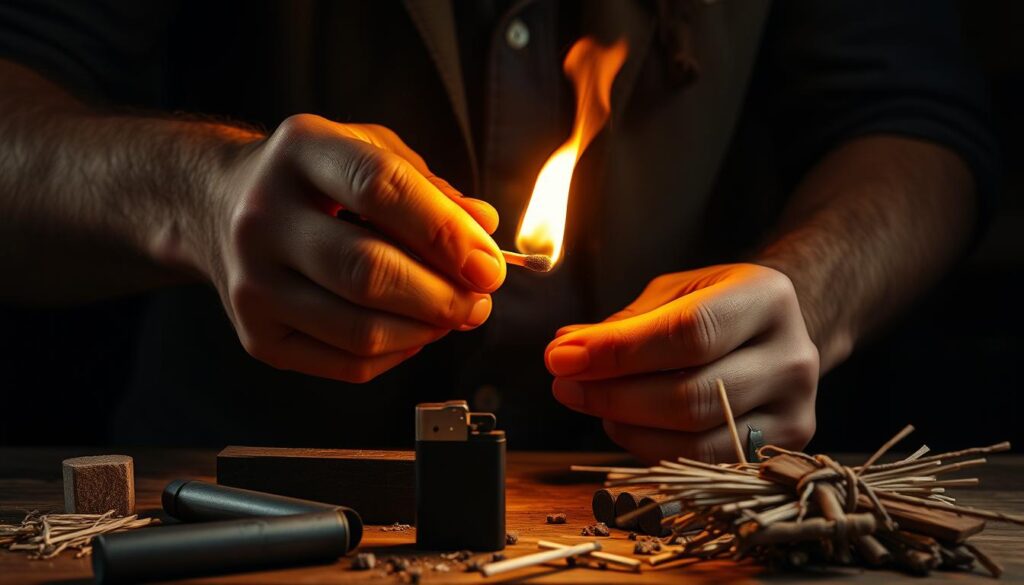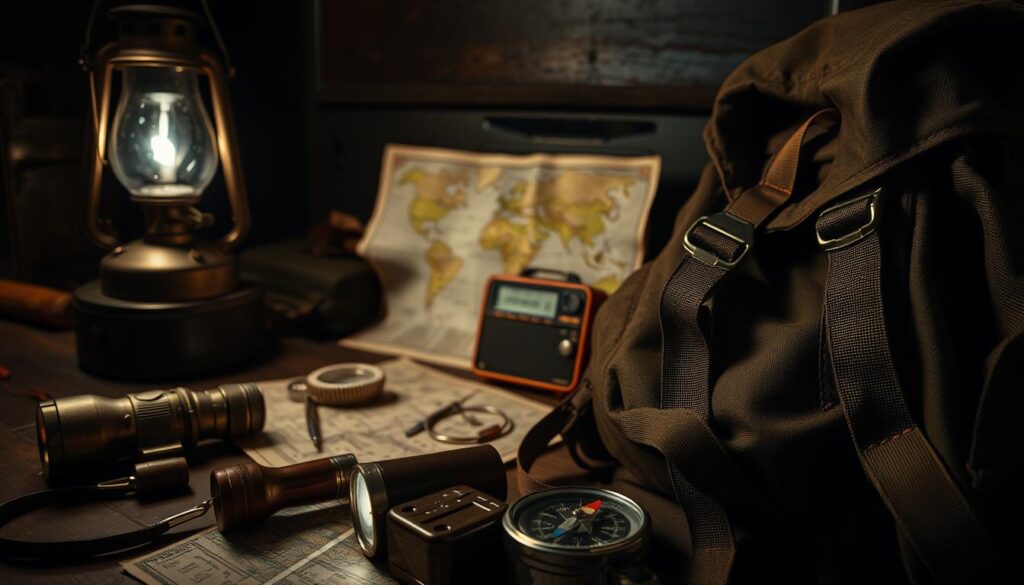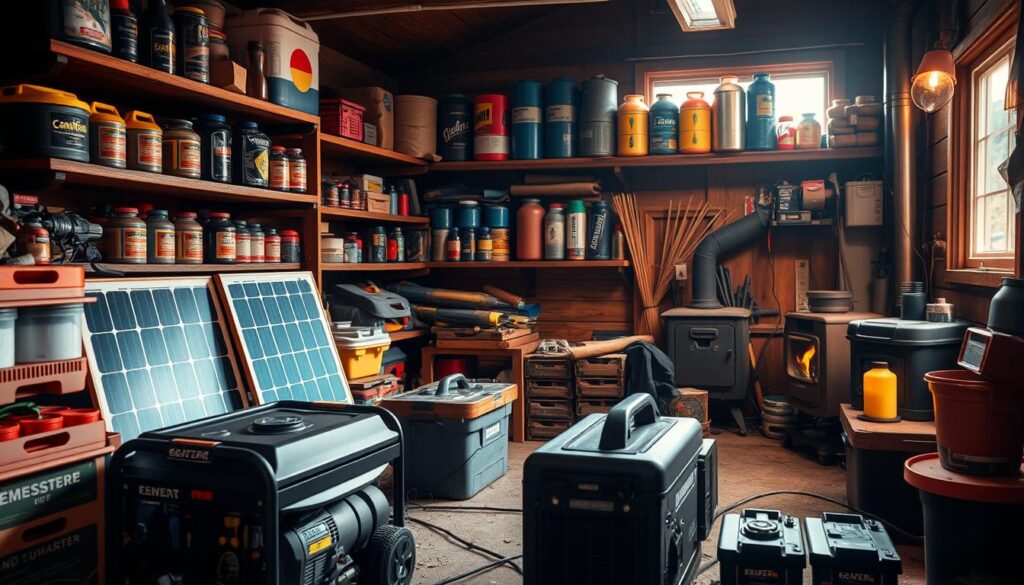Looking back on my outdoor adventures, I see that mastering fire starting is key. It has made my experiences better. Whether camping, hiking, or in survival situations, a good ignition source is essential.
Fire keeps us warm, cooks our food, purifies water, and gives us a sense of safety. For those who love the outdoors and survivalists, knowing how to start a fire quickly is critical. This guide will teach you the different ways to get good at fire ignition.
Key Takeaways
- Understanding the importance of fire ignition in outdoor activities
- Learning various methods for starting a fire
- Identifying reliable ignition sources
- Practicing fire ignition techniques for proficiency
- Applying fire ignition skills in survival situations
Understanding the Basics of Fire Ignition
Starting a fire is key for survival and fun outdoors. It’s a mix of science and skill. Knowing the basics is a must before learning more.
What is Fire Ignition?
Fire ignition is starting a fire that keeps burning. It needs enough heat to light the fuel, like wood or charcoal. The science behind it is about fuel, oxygen, and heat reacting together.
The Science Behind Fire
The science of fire is about a chemical reaction. Fuel, oxygen, and heat come together to create a fire. This reaction keeps the fire going, releasing heat and light.
| Element | Description |
|---|---|
| Fuel | Material that will burn, such as wood or charcoal |
| Oxygen | Oxygen is necessary to sustain the combustion reaction |
| Heat | The initial heat source that starts the combustion process |
Common Misconceptions
Many think starting a fire is easy or that some materials are better than others. But, it really takes knowing your materials and the environment. For example, dry leaves and twigs aren’t enough; you need tinder, kindling, and fuel.
Some also think starting a fire is simple. But, it’s more than that. It’s about understanding combustion, choosing the right materials, and knowing the weather and humidity.
Essential Materials for Fire Ignition
The success of starting a fire depends on the materials used. These can change based on the situation and where you are. Choosing the right materials is key for a successful fire, whether for camping, survival, or other outdoor activities.
Types of Ignition Sources
Ignition sources start any fire. Common ones include matches, lighters, and firestarters. The choice often depends on the situation, what you prefer, and the environment. For example, in wet conditions, a waterproof match or a ferrocerium rod (firesteel) might be better than a standard match.
Other ignition sources include battery-operated sparking devices and certain glass or stone that can focus sunlight. The goal is to pick an ignition source that works well in the given conditions.
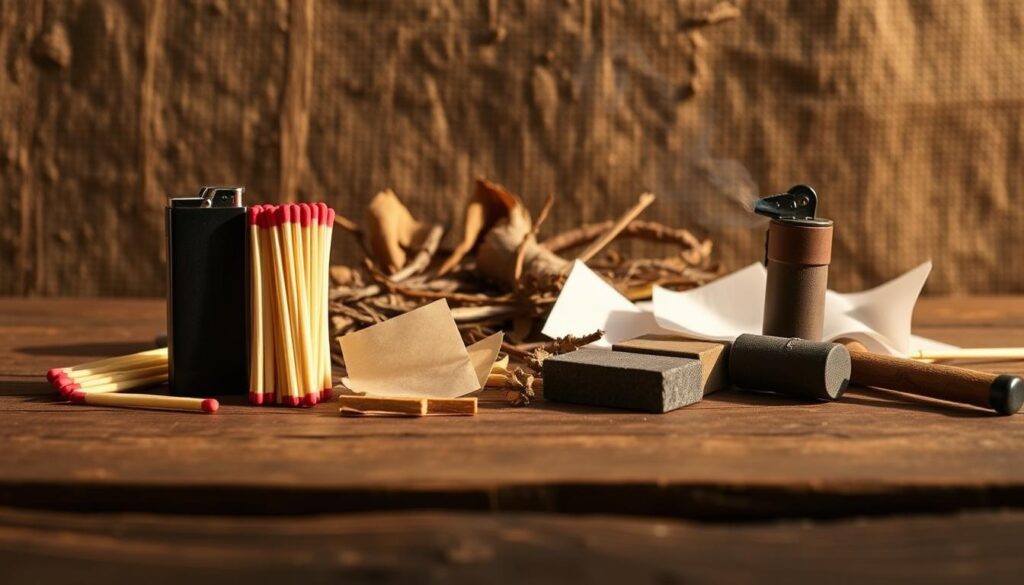
Best Fuel Options
Fuel for a fire includes tinder, kindling, and fuel logs. Tinder is the easiest to ignite, like dry leaves or small twigs. Kindling is slightly larger sticks added once the fire is burning well. Fuel logs are the biggest and keep the fire going.
Good fuel options are dry wood, charcoal, and other things that burn well. The type of fuel affects how long the fire lasts and how hot it gets.
Natural vs. Synthetic Materials
There’s a debate on using natural versus synthetic materials for fire ignition. Natural materials, like dry wood and leaves, are easy to find outside. But, they might be damp or hard to find in some places.
Synthetic materials, like paraffin wax or firestarters, are more reliable in bad weather. They offer a consistent, dry way to start a fire, which is important in survival situations.
“The best material is one that is dry, highly combustible, and readily available.”
| Material Type | Characteristics | Best Use Case |
|---|---|---|
| Natural | Dry wood, leaves, twigs | General camping or survival |
| Synthetic | Paraffin wax, firestarters | Wet or adverse weather conditions |
Choosing the Right Location for Ignition
Finding the right spot for starting a fire is key to a safe and successful experience. You need to think about several important factors. These factors can affect the safety and success of starting the fire.
Safety Considerations
When picking a spot for starting a fire, safety comes first. Stay away from things that can catch fire, like dry leaves or branches. Also, make sure you’re not too close to water or escape routes.
- Choose a flat, non-flammable surface.
- Avoid areas with dry leaves, grass, or other combustible materials.
- Keep a bucket of water or a fire extinguisher nearby.
Environmental Factors
Weather and environment also matter when starting a fire. Think about the wind, how wet or dry it is, and the weather forecast. This helps prevent the fire from spreading or dying out.
Key environmental factors to consider:
- Wind direction to prevent fire spread.
- Moisture levels to ensure the fire can sustain.
- Weather forecasts to prepare for possible changes.
Accessibility and Convenience
The spot you choose should also be easy to get to and use. Think about how easy it is to carry materials and if you have what you need nearby. Comfort is also important for those starting the fire.
By looking at these factors, you can make sure starting a fire is safe, successful, and easy.
Techniques for Effective Fire Ignition
Starting a fire is key for many outdoor activities. There are several ways to do it. Knowing these methods helps you pick the right one for your needs.
The Match Method
Using matches is a classic and easy way to start a fire. They are handy and work well. To use them right, hold the match at the right angle and make sure the tinder is dry and ready.
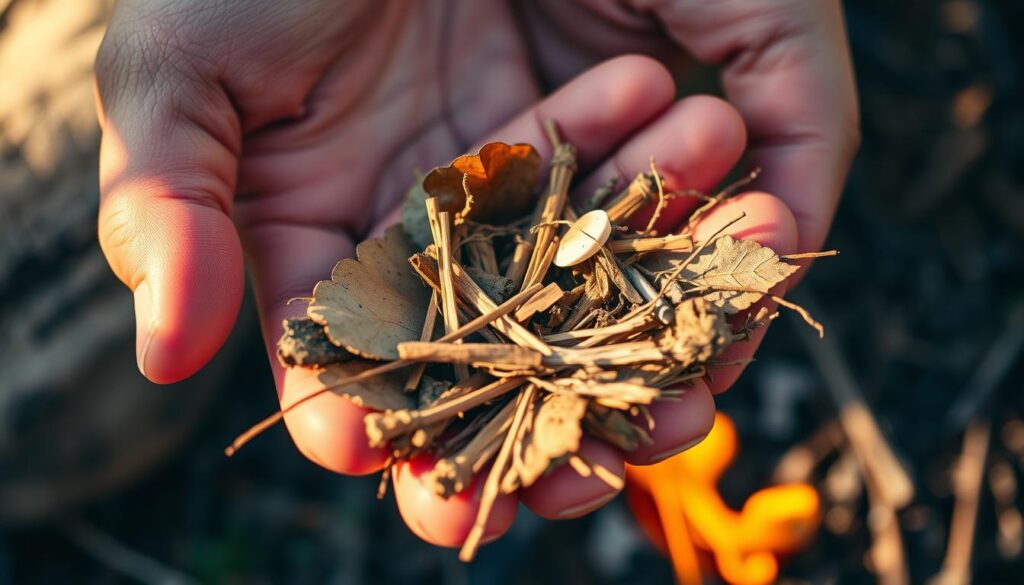
Using a Lighter
Lighters are also popular for starting fires. They work better than matches in windy weather. It’s important to keep the flame safe from the wind for a steady fire.
Firestarter Options
If you need something more reliable, try firestarters. Tools like ferrocerium rods or magnesium strikers work well in bad weather. They’re great for survival or when you can’t use other methods.
| Ignition Method | Reliability | Ease of Use |
|---|---|---|
| Matches | High | Easy |
| Lighters | Very High | Very Easy |
| Firestarters | Extremely High | Moderate to Difficult |
Building a Fire Structure
Learning to build a fire structure is key for both newbies and seasoned outdoor fans. A well-made fire structure helps start the fire well and keeps it burning safely.
The type of fire structure you pick can greatly affect its success. Different places and weather need different fire-building methods.
Teepee vs. Log Cabin Styles
The teepee and log cabin styles are two common fire structures. The teepee style is great for starting fires fast because it lets air flow well and focuses heat on the tinder. The log cabin style is more stable and keeps a fire burning longer.
The teepee is often chosen in survival situations where starting a fire quickly is key. But, it might need more upkeep because it’s less stable.
What Works Best for Different Conditions
Choosing between teepee and log cabin styles depends on the situation. For example, in wet conditions, a log cabin style works better because it exposes more material to the fire starter, making it easier to start.
In dry and windy conditions, a teepee is better. It starts fires fast and has good airflow, which helps control the fire’s size.
Layering Materials Effectively
It’s important to layer materials well, no matter the structure. Start with tinder at the bottom, then kindling, and finish with larger logs around your structure.
Here’s a simple guide to layering:
| Layer | Material | Purpose |
|---|---|---|
| 1st Layer | Tinder | Easy to ignite, starts the fire |
| 2nd Layer | Kindling | Small twigs, builds the fire |
| 3rd Layer | Logs | Larger wood, sustains the fire |
By layering materials well and picking the right structure for your situation, you can have a successful and lasting fire.
Weather Considerations for Fire Ignition
The weather’s impact on starting a fire is huge. Weather conditions can make it easier or harder to start and keep a fire going. Knowing about these conditions is key for anyone who loves spending time outdoors.
Wind Impact on Fire
Wind can be both good and bad for starting a fire. A light breeze can help the fire grow by providing oxygen. But strong winds can make it hard to start a fire and can spread it fast.
To deal with wind, you can use rocks, snow walls, or dig a pit to protect your fire. Also, picking a wind-resistant lighter can help a lot.
Igniting in Wet Conditions
Starting a fire when it’s wet is really tough. Moisture in the air and on surfaces makes it hard for sparks to catch and keep burning. To get around this, you need to choose the right materials.
It’s important to use dry tinder and kindling. Look for dry materials, like under tree canopies or in the dead center of logs. Also, using a high-temperature spark source, like a ferrocerium rod, can work well.
Seasonal Variability
Each season brings its own fire-starting challenges. In summer, dry conditions make fires easier but also raise the risk of wildfires. Winter, on the other hand, is colder and wetter, making it harder to start a fire.
| Season | Challenges | Tips for Ignition |
|---|---|---|
| Summer | High risk of wildfires, dry conditions | Be cautious with fire safety, fully extinguish fires |
| Winter | Cold and wet conditions | Use dry materials, protect ignition source from wind |
| Spring/Autumn | Variable conditions, possible wet or dry spells | Be ready for changing weather, have different ignition sources |
Knowing how the seasons affect fire starting and being ready with the right tools and materials can really help. This way, you can start a fire more easily.
Safety Tips During Fire Ignition
Fire ignition safety is a must. A safe and controlled area is key to avoid accidents. Here are the top safety tips for fire ignition.
Personal Protection Equipment
Wearing the right gear is essential when dealing with fire. This includes heat-resistant gloves and a fire extinguisher or blanket nearby. Always keep a safe distance from the fire. The fire safety guidelines also suggest wearing protective clothing like long sleeves and closed-toe shoes.
Fire Extinguishing Methods
Knowing how to put out a fire is as important as starting one. There are several ways to do this, like using water, smothering it, or a fire extinguisher. It’s vital to know the fire type and choose the right method. For example, water is not safe for electrical fires.
“A fire can quickly get out of control if not managed properly.”
Leaving No Trace Principles
When starting a fire, follow the Leave No Trace principles. This means choosing a safe spot, keeping the fire small, and fully putting it out before leaving. These steps help protect our environment for the future.
In summary, fire ignition safety involves personal protection, knowing how to extinguish fires, and caring for the environment. By focusing on these areas, we can have a safe and fun fire experience.
Troubleshooting Common Issues
Mastering fire ignition involves troubleshooting. Even with careful planning, problems can occur. Knowing how to fix these issues is key to a successful fire.
When the Fire Won’t Ignite
A fire that won’t ignite can be frustrating. First, check your fire starter. Make sure it’s dry and works well. If using matches or a lighter, check if they’re damp or out of fuel.
Also, check the tinder or kindling. It might be too damp or not dry enough. Try drying out the materials or use dry ones instead. Also, make sure your fire structure allows for good airflow.

Dealing with Excess Smoke
Excess smoke means the fire isn’t burning well. This can happen if the fire lacks oxygen or if the materials are damp. To fix this, ensure your fire gets enough air by adjusting its structure or using a well-ventilated fire pit.
Using dry, seasoned wood can also help. Green or damp wood produces more smoke. Choose the right wood to reduce smoke and get a cleaner burn.
Managing an Uncontrollable Blaze
Sometimes, a fire gets too big to handle. This is dangerous and needs quick action. Stay calm and evaluate the situation first.
If the fire is too big, you might need to put it out. Use sand to smother it or a fire extinguisher. To avoid this, start with a small fire and watch it grow. Keep water or a fire extinguisher nearby for safety.
Fire Ignition in Outdoor Activities
Starting a fire is key for survival and fun outdoors. Whether camping or having a barbecue, knowing how to start a fire is vital.
Activities like camping, survival, and backyard gatherings need fire. Fire ignition is more than just a convenience. It’s about safety and staying warm.
Camping and Survival Situations
In the wild, fire gives warmth, light, and a way to cook. It’s important to know how to start a fire. You can use dry leaves, twigs, and other kindling materials.
| Activity | Fire Ignition Method | Importance |
|---|---|---|
| Camping | Using matches or lighters, and kindling materials | High |
| Survival Situations | Firestarters, friction methods | Critical |
| Backyard Gatherings | Using fire pits, charcoal, and kindling | Moderate to High |
Backyard Fire Pits
Fire pits are great for backyard fun. They let you control the fire for cooking and ambiance.
Barbecues and Cooking
Starting a fire is also key for barbecues. It makes sure you can cook safely and well.
In summary, learning to start a fire is vital for many outdoor activities. It makes things safer, more convenient, and more fun.
Emergency Situations and Fire Ignition
A fire can be a lifeline in emergency situations. It provides warmth, light, and a way to signal for help. Knowing how to start a fire is key. This section will guide you on starting fires for rescue and survival.
Igniting a Fire for Rescue
When you’re stranded or lost, a fire can signal for help. Choose a spot that’s easy to see, like a ridge or clearing. Use dry, flammable materials like leaves, grass, or small twigs.
This will create a fire that smokes a lot during the day and glows at night. Understanding fire emergencies helps you start a fire better.
Fire Ignition in Survival Scenarios
In survival situations, fire provides warmth, light, and a way to cook food. You’ll need a fire starter (like matches or lighters) and tinder (dry leaves, grass, or small twigs). Building a fire structure, like a teepee, helps keep it going.
Remember, wind direction and moisture matter to keep the fire burning. Learning to start a fire can save your life in emergencies. It’s essential for signaling help or providing warmth and light.
Legal and Environmental Responsibilities
Starting a fire outdoors comes with big legal and environmental duties. As more people enjoy outdoor fires, knowing the rules and best ways to start a fire is key.
Understanding Local Fire Regulations
Before starting a fire, knowing the local rules is vital. These rules change a lot based on where you are, like the weather, plants, and how many people live there. I always talk to local officials or park rangers to find out about any fire rules or permits needed.
Key aspects to consider include:
- Permits and licenses required for fire ignition
- Restricted areas where fire ignition is prohibited
- Specific guidelines for fire size and containment
Responsible Fire Usage
Using fire responsibly is more than just following the law. It’s also about being kind to others and taking care of the environment. This means making sure fires are fully out when they’re done and choosing what you burn carefully.
Some best practices for responsible fire usage include:
- Using fire pits or rings when available
- Keeping a bucket of water or a fire extinguisher nearby
- Monitoring wind conditions to prevent fire spread
Environmental Impact of Fire Ignition
Fire has a big effect on the environment, from the air we breathe to where animals live. It’s important to understand these effects to lessen the harm. For example, I avoid burning things that give off bad fumes and keep fires small.
We can make fires better for the environment by using wood that’s good for the planet and making sure fires are fully out when we’re done.
Resources for Further Learning
To learn more about fire ignition and safety, there are many resources. These can help you understand fire techniques better. They also promote safe practices.
Recommended Reading Materials
Books on fire safety and techniques are full of useful information. They come from trusted authors and publishers. These books give insights into fire ignition methods and safety rules.
Online Education and Training
Online courses and workshops are great for learning. They cover fire safety, ignition techniques, and emergency prep. These programs are structured for your convenience.
Community Resources and Programs
Local fire departments and community programs offer training. They teach about fire safety and ignition. Joining these programs gives you hands-on experience and connects you with fire safety experts.
Using these resources, you can keep learning about fire ignition and safety. This ensures you’re ready for different situations. It also helps promote fire safety and responsible practices.
FAQ
What is fire ignition, and why is it important?
Fire ignition is starting a fire. It’s key for outdoor fun, survival, and emergencies. Knowing how to start a fire keeps you safe and warm outdoors.
What are the basic elements required for fire ignition?
You need three things to start a fire: an ignition source, fuel, and oxygen. Sources include matches, lighters, or firestarters. Fuel is dry leaves, twigs, or other things that burn.
How do I choose the right location for fire ignition?
Pick a safe spot for starting a fire. Look for places away from flammable stuff, with good wind direction, and easy access. Also, think about the weather and local rules.
What are some effective techniques for fire ignition?
Good ways to start a fire include using matches, lighters, or firestarters. Also, building a fire structure like a teepee or log cabin helps a lot.
How do weather conditions impact fire ignition?
Weather like wind, rain, and snow can make starting a fire hard. Knowing how to start a fire in tough weather is important for outdoor lovers and survival.
What safety precautions should I take during fire ignition?
Be safe when starting a fire. Wear protective gear, have a plan to put out the fire, and follow Leave No Trace to protect the environment.
What are some common issues that may arise during fire ignition, and how can I troubleshoot them?
Problems like hard-to-start fires, too much smoke, or big blazes can happen. To fix these, know the reasons and have solutions, like changing the fire structure or using different starters.
How is fire ignition used in different outdoor contexts?
Fire starting is used for camping, survival, backyard fires, barbecues, and cooking. Knowing how to start a fire in these situations helps you stay safe.
What is the role of fire ignition in emergency situations?
Starting a fire is vital in emergencies like rescue and survival. It gives warmth, light, and a way to signal for help.
What are the legal and environmental responsibilities associated with fire ignition?
Fire starting must follow local rules and protect the environment. It’s important to know these rules and how to minimize harm to nature.
Where can I learn more about fire ignition and safety?
For more on fire starting and safety, check out books, online courses, workshops, and community programs. These can teach you how to start fires safely and responsibly.

